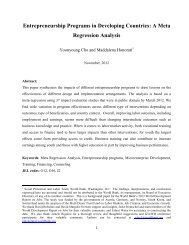Investing in the future: Creating opportunities for young rural ... - IFAD
Investing in the future: Creating opportunities for young rural ... - IFAD
Investing in the future: Creating opportunities for young rural ... - IFAD
You also want an ePaper? Increase the reach of your titles
YUMPU automatically turns print PDFs into web optimized ePapers that Google loves.
heterogeneity of <strong>rural</strong> youth, youth may have limited usefulness as a social<br />
category around which major <strong>rural</strong> development policy <strong>in</strong>itiatives should be<br />
developed.<br />
It is certa<strong>in</strong>ly <strong>the</strong> case that, with a few exceptions (such as South Africa), youth<br />
as a target group is not a major policy priority of most governments <strong>in</strong> low<strong>in</strong>come<br />
develop<strong>in</strong>g countries. M<strong>in</strong>istries of Youth are generally very poorly<br />
resourced and are usually subsumed (or comb<strong>in</strong>ed) with o<strong>the</strong>r government<br />
responsibilities, most commonly culture, sports and education. With regard to<br />
national poverty alleviation strategies, youth receives very little attention <strong>in</strong> most<br />
Poverty Reduction Strategy Papers (PRSPs). A 2005 overview of PRSPs<br />
conducted by <strong>the</strong> Economic Commission <strong>for</strong> Africa concluded that „youth are still<br />
be<strong>in</strong>g overlooked‟. In particular, <strong>the</strong> chapters <strong>in</strong> PRSPs on agriculture rarely<br />
mention youth. Similarly, <strong>the</strong> standard chapter on „crosscutt<strong>in</strong>g‟ issues focuses<br />
only on gender, environment and HIV/AIDS. In only two out of 12 PRSPs <strong>for</strong><br />
African countries that were reviewed youth is s<strong>in</strong>gled out as a „special group <strong>in</strong><br />
ma<strong>in</strong>stream<strong>in</strong>g employment‟, and, even <strong>in</strong> <strong>the</strong>se exceptional cases, urban youth<br />
is of greater concern than <strong>rural</strong> youth. Even <strong>the</strong> current World Development<br />
report on youth, devotes only four paragraphs to how to expand <strong>rural</strong><br />
<strong>opportunities</strong> <strong>for</strong> youth and focuses ma<strong>in</strong>ly on <strong>rural</strong> non-farm activities.<br />
Only a relatively small number of recent <strong>IFAD</strong> projects specifically targeted<br />
youth. These projects were ma<strong>in</strong>ly concentrated <strong>in</strong> <strong>the</strong> NENA region, where levels<br />
of open unemployment among <strong>rural</strong> youth are particularly high. However,<br />
considerably more attention is now be<strong>in</strong>g given to youth programm<strong>in</strong>g, with a<br />
particular focus on promot<strong>in</strong>g youth employment through both farm and nonfarm<br />
enterprise development. In <strong>the</strong> past, <strong>IFAD</strong> provided only limited fund<strong>in</strong>g <strong>for</strong><br />
capacity development, especially skills tra<strong>in</strong><strong>in</strong>g, <strong>for</strong> youth <strong>in</strong> agricultural<br />
activities. In part, this was because <strong>the</strong>re is no specific education component <strong>in</strong><br />
<strong>IFAD</strong>‟s core mandate, although vocational tra<strong>in</strong><strong>in</strong>g is offered across all<br />
agricultural specializations. <strong>IFAD</strong> is, however, becom<strong>in</strong>g <strong>in</strong>creas<strong>in</strong>gly <strong>in</strong>terested <strong>in</strong><br />
provid<strong>in</strong>g support <strong>for</strong> targeted tra<strong>in</strong><strong>in</strong>g <strong>for</strong> <strong>young</strong> farmers.<br />
B. KEY FEATURES OF RURAL YOUTH LIVELIHOODS<br />
Most <strong>rural</strong> youth are ei<strong>the</strong>r employed (waged and self-employed) or not <strong>in</strong> <strong>the</strong><br />
labour <strong>for</strong>ce. The issue, <strong>the</strong>re<strong>for</strong>e, is not so much about unemployment, but<br />
serious under-employment <strong>in</strong> low productivity, predom<strong>in</strong>antly household-based<br />
activities. The ILO estimates that about 300 million youth (one-quarter of <strong>the</strong><br />
total) live on less than US$ 2 a day. The unemployed are ma<strong>in</strong>ly better-educated<br />
urban youth who can af<strong>for</strong>d to engage <strong>in</strong> relatively protracted job searches. It is<br />
better, <strong>the</strong>re<strong>for</strong>e, to focus on improv<strong>in</strong>g <strong>the</strong> livelihoods of <strong>the</strong> most<br />
disadvantaged youth ra<strong>the</strong>r than those who are unemployed. Access to key<br />
productive assets, particularly land, is a critical issue <strong>for</strong> <strong>young</strong> people.<br />
It is often argued (although usually not based on robust evidence) that <strong>rural</strong><br />
youth are <strong>in</strong>creas<strong>in</strong>gly dis<strong>in</strong>terested <strong>in</strong> smallholder farm<strong>in</strong>g and tend to travel<br />
nationally and, <strong>in</strong>creas<strong>in</strong>gly, across <strong>in</strong>ternational borders, <strong>in</strong> search of<br />
employment. This exodus of <strong>young</strong> people from <strong>rural</strong> areas is result<strong>in</strong>g <strong>in</strong> a<br />
marked age<strong>in</strong>g of <strong>the</strong> <strong>rural</strong> population <strong>in</strong> some countries. In some prov<strong>in</strong>ces <strong>in</strong><br />
Ch<strong>in</strong>a, <strong>for</strong> example, <strong>the</strong> average age of farmers is 45-50 years. Recent research<br />
4

















